The Supplemental Nutrition Assistance Program (SNAP) serves about 1.6 million Georgians on average every month, and more than half are adults. While most adults who receive food assistance work, some SNAP recipients are more likely to be unemployed than their counterparts. Federal law requires non-disabled childless individuals to participate in some qualified work activity within a three-month time period to remain eligible for food assistance. The technical term for these adults is an Able-Bodied Adult Without Dependents, or ABAWD for short.
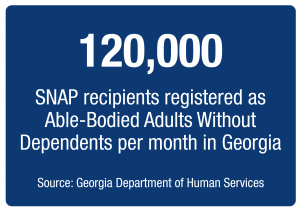 Across Georgia, more than 120,000 unemployed SNAP recipients are registered for SNAP as ABAWDs. These adults are at a high risk of losing access to food assistance due to a stringent time-limit policy on benefits. Federal waivers provide key protections to participants in Georgia communities where employment opportunities are few. Without the time-limit waivers in place, thousands of Georgians abruptly lose food assistance when the three-month period ends.[1] The Georgia Department of Human Services expects the 66 remaining Georgia counties with waivers will lose them by the start of 2019, meaning ABAWDs in all of the state’s 159 counties will be subject to time limits.[2]
Across Georgia, more than 120,000 unemployed SNAP recipients are registered for SNAP as ABAWDs. These adults are at a high risk of losing access to food assistance due to a stringent time-limit policy on benefits. Federal waivers provide key protections to participants in Georgia communities where employment opportunities are few. Without the time-limit waivers in place, thousands of Georgians abruptly lose food assistance when the three-month period ends.[1] The Georgia Department of Human Services expects the 66 remaining Georgia counties with waivers will lose them by the start of 2019, meaning ABAWDs in all of the state’s 159 counties will be subject to time limits.[2]
People subject to the time-limit face hardships, which Georgia’s leaders can mitigate through:
- Continued pursuit of geographic time-limit waivers in counties still lagging in employment growth since the recession
- Expanded access to employment and training services that target childless adults in areas suffering persistent high unemployment
Work Requirements and Waivers in Georgia
In 1996, Congress authorized time limitations for able-bodied adults in the SNAP program. Childless adults who are not disabled are required to work at a paid job, take on a substantial amount of volunteer opportunities, or actively engage in job search activities. Nonprofit and public-sector organizations that help SNAP recipients find work can be scarce. When unemployment spiked after the recession that started in 2007, demand for work programs surged. Policy makers realized the time-limit became too punitive for SNAP participants in areas of high unemployment. In response, Congress approved statewide waivers that exempted childless adults from the time-limit.[3] Georgia secured approval for a statewide waiver in 2009. In 2016, the statewide waiver program expired, leaving Georgia with only partial waivers since.
To continue receiving food assistance, Able-Bodied Adults Without Dependents must:
For more details on specific work requirements in Georgia, see Work Requirements, Time Limits Constrain Food Assistance |
Despite the use of waivers, the program does not require states to offer slots to childless adults for job training or workfare programs. The federal government also does not provide sufficient funding through SNAP for job preparation, placement and retention. So, the waivers only offer temporary relief to states and SNAP recipients. Nearly 10 years after the Great Recession, many states including Georgia are still relying on waivers to exempt their childless SNAP recipients from the time limit.
Georgia is one of 27 states that uses a partial waiver that exempts some counties from the time limit cut off. As of June 2018, 93 Georgia counties impose the time limit.
In 2017, Georgia officials lifted the waiver and re-imposed a time limit in 24 counties. With the return of the time limit, nearly 7,000 childless adults abruptly fell from the SNAP rolls. Federal proposals such as the 2018 Farm Bill reauthorization, the 2019 White House Budget, and rule changes at the United States Department of Agriculture (USDA) threaten to tighten restrictions for waiver eligibility, limiting the state’s ability to exempt childless adults from the time-limit and threatening food access for millions more SNAP users.[4] These trends and possible massive changes to the SNAP work requirements and waiver eligibility means Georgia needs to continue to take advantage of the flexibility waivers offer.
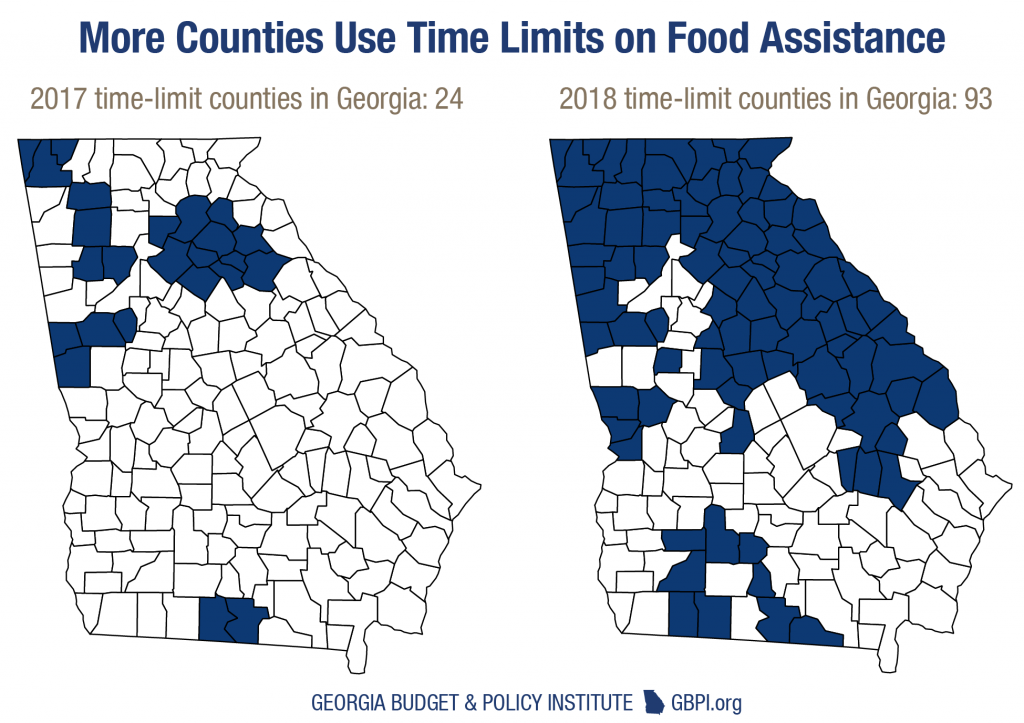
Who are Time-Limited SNAP Users?
Although demographic information on childless adults is limited at the state level, national data indicate they are a diverse group. Ages range from 18 to 49 with most of them likely to fall into the 18 to 29 group. Nearly half of this group are women. Half of ABAWDs nationwide are white, one third are black and one tenth are Latino.[5]
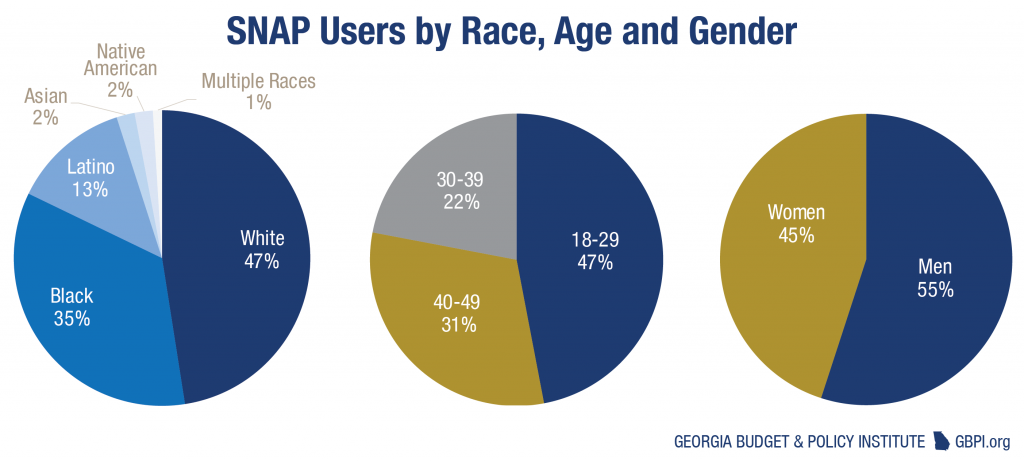
Data from the Georgia Department of Human Services illustrate the ABAWD share of SNAP recipients by county. Childless adults without disabilities make up a larger share of the SNAP population outside of metro Atlanta, as the map below shows.[6] These adults make up 12 percent of SNAP recipients in Taliaferro, Wilkinson, Terrell, Crawford, McIntosh, Talbot, and Lincoln counties, the highest percentages seen in Georgia.
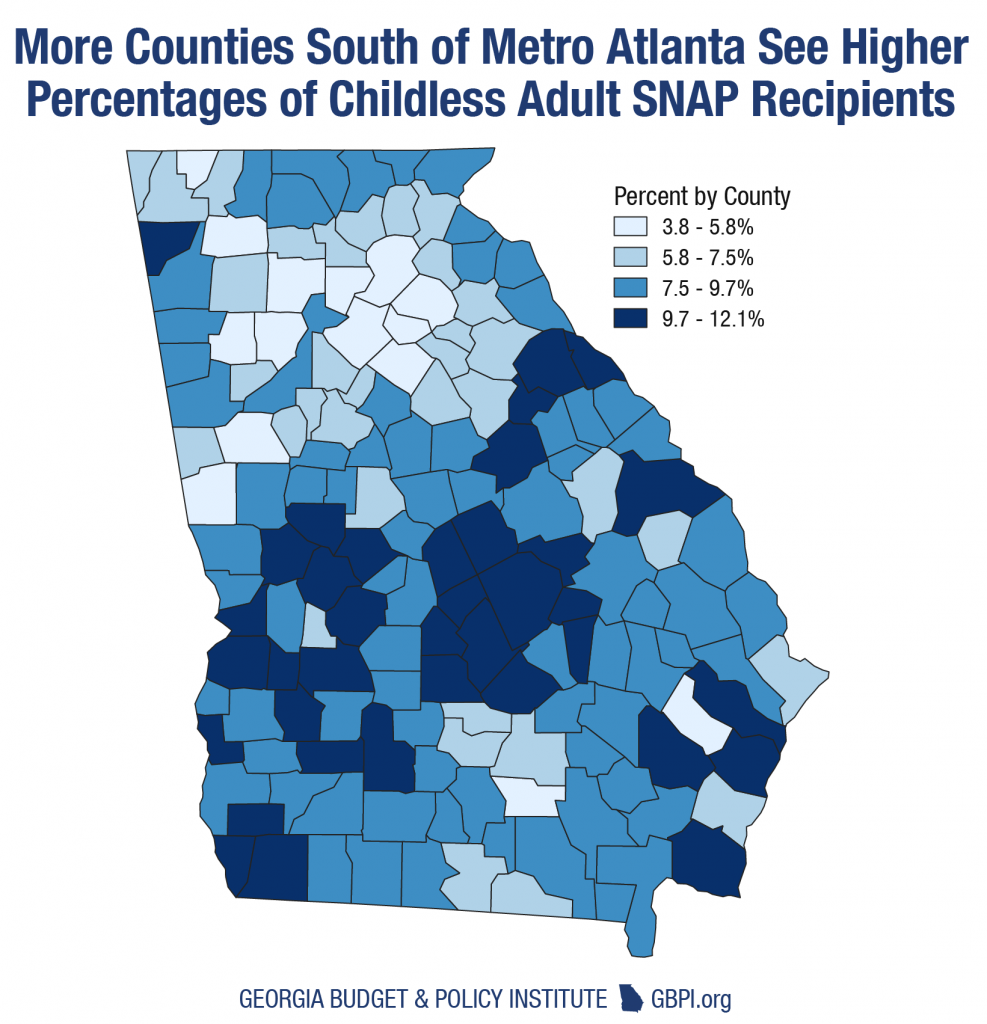
The most common characteristic among these childless adults is the extreme economic hardship that these individuals face. Only about 30 percent of these individuals earn some type of income. Those who do earn some type of income are only making an average of $2,000 annually, according to the USDA.
These Georgians confront many barriers to work, including lack of reliable transportation, criminal records, insufficient housing and limited education. Many of these SNAP participants do work, but not enough to meet requirements. They often perform a handful of odd jobs to try to pay for daily necessities.[7]
Waivers Give Flexibility to Communities with Weak Economies
Georgia’s economy continues to improve overall, but the long tail of the Great Recession still lingers in some counties. This is an important consideration for SNAP, since states request partial or statewide waivers based on local employment conditions.
The USDA’s primary waiver-granting indicator is a pattern of high unemployment reported by the U.S. Department of Labor. Most experts agree the official unemployment rate does not fully reflect the lack of economic opportunity in a given area, since it does not include people who leave the workforce entirely or those working part-time who prefer full-time work.[8] And some areas in the state might have added jobs but post-recession wages remained mostly stagnant for everyone.[9] Time-limit waivers provide critical protection for SNAP participants in these areas as the labor market stays weak.
With a persistently sluggish economy in parts of Georgia, the labor market ends up leaving out many in the childless and non-disabled adult category of SNAP recipients. Georgia’s unemployment rate stood at 4.4 percent in 2006, a year before the recession started in December 2007. More than a decade later, Georgia’s unemployment rate returned to pre-recession levels. Still, the relatively healthy statewide employment number masks local problems. County-level unemployment rates show only 40 percent of Georgia’s 159 counties are back to pre-recession levels.[10]
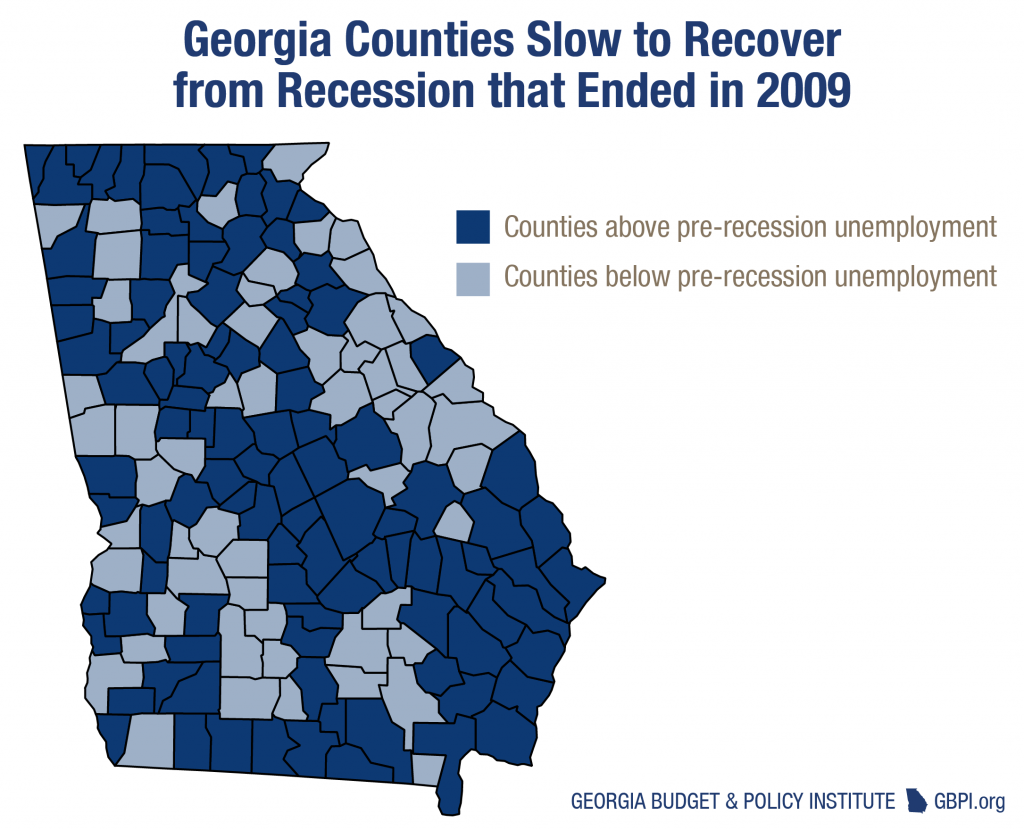
Persistent racial inequities in employment also pose significant challenges for people of color who fall within the childless adult category. Immediately following the recession 16 percent of black Georgians were unemployed, compared to 8 percent for white Georgians. In 2016, those rates dropped dramatically, with black unemployment at 8 percent and white unemployment at 3 percent.[11] Although both groups cut their unemployment rates in half at the state level, the gap persists. The economic realities of people of color become clearer when examined at the county level. In Georgia’s Bibb County, the unemployment rate for white residents is 6 percent, compared to 16 percent for black residents. [12]
People of color facing the time limit often face subconscious bias or outright discrimination that contributes to higher-than-average unemployment. Even when education and skills are equal, white job applicants are more likely to receive callbacks for job interviews than black applicants, research shows. People of color are also more likely to carry criminal records for minor or nonviolent infractions.[13] These large racial gaps and stubborn inequities make finding a job within three months an especially heavy burden for people of color receiving SNAP in Georgia.
Waivers Help Maintain Access to Food
Food assistance is a proven tool to help individuals and families mitigate hunger. The abrupt loss of food assistance is particularly harmful for unemployed childless adults who already cope with little to no supplemental income. The loss of food assistance is linked to life-threatening health conditions, including obesity, diabetes and hypertension.[14]
The Georgia Food Banks Association estimates that about 16 percent of the state’s households struggle to afford enough nutritious food. Georgia ranks seventh nationally for food insecurity. Clay County is home to a food insecurity rate of 28 percent, the highest in the state. Clay, along with neighboring southwest Georgia counties including Terrell, Dougherty and Early are home to the highest percentages of SNAP recipients, high percentages of ABAWDs, as well as high levels of poverty.[15]
Too many Georgians are still struggling, and SNAP remains critical for childless adults in communities left out of the recovering economy. People who get food assistance who are subject to the time limit carry a higher risk of losing assistance and suffering from hunger than their counterparts. The waivers play a critical role in helping childless adults mitigate those hunger risks.
SNAP benefits provide a modest boost to household food budgets, with about $1.43 per person going towards meals.[16] Although small, these benefits play a significant role in alleviating hunger and reducing poverty for people subject to the SNAP work requirements.
SNAP Works a Model to Build On
In 2017, Georgia began operating various voluntary employment and training programs for ABAWDs across the state. The program SNAP Works is designed to target and help childless adults meet their SNAP work requirements. The program also provides participants with caseworkers who connect them to opportunities to gain skills, training or experience to improve their employment prospects.
The state does offer a mandatory pilot program to support these SNAP recipients, but it is limited to 10 counties[17]. Participants in these counties receive enhanced employment and training services. The Georgia Department of Human Services implemented a third-party model for the delivery of services to improve capacity and the administration of services.
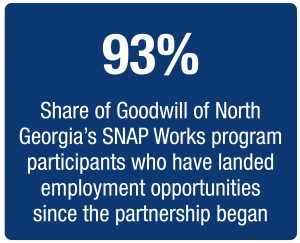 The state operates a model partnership with the Goodwill of North Georgia, a career services organization with sites across the state. Ninety-three percent of the organization’s SNAP Works program participants land employment opportunities.[18] While these services are currently available to childless adults in only a few counties, the organization plans to expand the services to the remainder of the state in 2019. Statewide expansion of these enhanced services is timely since Georgia intends to lift the time-limit waiver in all 159 counties next year.
The state operates a model partnership with the Goodwill of North Georgia, a career services organization with sites across the state. Ninety-three percent of the organization’s SNAP Works program participants land employment opportunities.[18] While these services are currently available to childless adults in only a few counties, the organization plans to expand the services to the remainder of the state in 2019. Statewide expansion of these enhanced services is timely since Georgia intends to lift the time-limit waiver in all 159 counties next year.
Expanding and strengthening partnerships with organizations that improve the workforce outcomes for SNAP recipients is a sound way to help put them on a path to self-sufficiency. The most effective programs connect people to specific high-growth, high-demand employers that pay workers a livable wage and help them climb the economic ladder. Atlanta CareerRise, a metro Atlanta workforce collaborative, funded training in 2016 for nursing, information technology, advanced manufacturing and construction. The program’s graduates collectively reduced their SNAP use by 71 percent due to their participation, immediate employment, and wage growth after placements.[19] The state can expand its third-party model to include additional community-based partnerships statewide, similar to those supported by Atlanta CareerRise.
Conclusion
When the SNAP time-limit requirement is paired with education, job training or work opportunities, childless adults in Georgia are more likely to maximize the benefits of SNAP within the three-month time period. However, when the state has to impose time limits, childless adults living in poverty are at a higher risk of losing SNAP’s already meager $5 a day for food which distances them further from work.
Evidence shows SNAP waivers provide needed flexibility for communities with weak economies and help a difficult-to-serve group of people maintain access to food. Lawmakers can strengthen SNAP’s benefit to adults without children by investing in targeted training and job services that allow more Georgians to stay self-supporting. These services are especially important in communities subject to the three-month time limit, since it’s crucial that people get back on a path to success when they abruptly lose food benefits.
Waivers are especially critical in areas where unemployment rates remain unusually high. The state can also provide targeted employment and training services to improve access to economic opportunity for childless adults. Greater investment in SNAP Works and its partnerships also ensures that the program maximizes its promise as a tool to help people stay on their feet and on the path to self-sufficiency.
Endnotes
[1] Georgia State University Fiscal Research Center (July 25, 2017), Data Snapshot: Changes to Georgia’s Supplemental Nutrition Assistance Program. https://frc.gsu.edu/files/2017/07/Changes-to-Georgia-SNAP_-July-2017.pdf
[2] Georgia Department of Human Services Fiscal Year 2017 Fact Book
[3] Bolen, E. & Dean, S. (2018). Waivers add key state flexibility to SNAP’s three-month time limit. Washington, D.C. Center on Budget and Policy Priorities.
[4] Camardelle, A. (2018). Food assistance for 1.7 million Georgians at risk in federal proposals. Atlanta, GA: Georgia Budget and Policy Institute
[5] Carlson, S., Rosenbaum, D., & Keith Jennings, B. (2016). Who are the low-income childless adults facing the loss of SNAP in 2016? Washington, D.C.: Center on Budget and Policy Priorities.
[6] GBPI’s analysis of ABAWD data retrieved from the Georgia Department of Human Services.
[7] Carlson, S., Rosenbaum, D., & Keith Jennings, B. (2016). Who are the low-income childless adults facing the loss of SNAP in 2016? Washington, D.C.: Center on Budget and Policy Priorities.
[8] Thomhave, K. (2016). Able bodies, empty stomachs: an analysis of the SNAP ABAWD policy and how to limit its impact. Washington D.C.: The Congressional Hunger Center.
[9] Tharpe, W. (2018). Fact sheet: Georgians hold untapped potential. Atlanta, GA: Georgia Budget & Policy Institute.
[10] GBPI analysis of data retrieved from the U.S. Bureau of Labor Statistics, years 2006-2017
[11] Economic Policy Institute analysis of Current Population Survey data
[12] U.S. Census Bureau, American Community Survey 1-year estimates for years 2010 and 2016.
[13] Thomhave, K. (2016). Able bodies, empty stomachs: an analysis of the SNAP ABAWD policy and how to limit its impact. Washington D.C.: The Congressional Hunger Center.
[14] SNAP, food security, and health. (2015). Madison, WI: Institute for Research on Poverty.
[15] GBPI analysis of Feeding America Map the Meal Gap data, 2018 (2016 data)
[16] Center on Budget and Policy Priorities analysis of SNAP use in Georgia, 2018
[17] Mandatory Enhanced SNAP E&T Counties: Bulloch, Chatham, Cherokee, Clayton, DeKalb, Douglas, Glynn, Gwinnett, Henry, Rockdale
[18] Datapoint listed on the Goodwill of North Georgia’s web page for SNAP employment and training program. Retrieved June 26, 2018 http://goodwillng.org/SNAP.aspx
[19] Job training programs that work: economic impact of job training programs in Metro Atlanta. Atlanta, GA: Atlanta CareerRise









